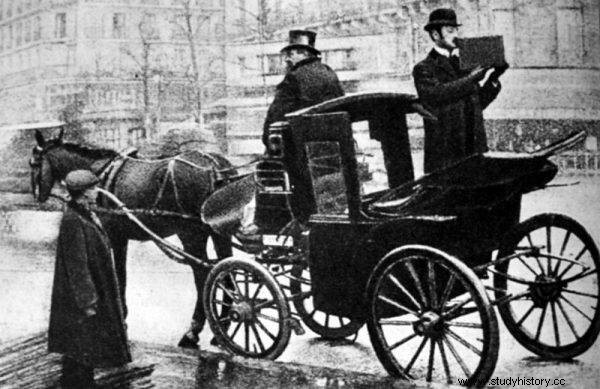Called the Columbus of cinematography, the third brother of Lumière and the first filmmaker. Prószyński spent almost his entire life building and improving the camera.
Even before Kazimierz Prószyński started any work, Poles were not idle. The constructor was on the threshold of adulthood when Piotr Lebiedziński improved his type of apparatus. Besides, people in many countries made attempts to move the photography and enliven the image. In the world - of course Thomas Edison and the Lumière brothers. However, when it comes to creativity, Polish inventors were not inferior to them.
Heavy cameras, undressing ladies
Lebiedziński's construction made use of glass plates - a pain in the contemporary cameras. They were neither light nor durable. If we add to this the compulsion to turn the crank to rewind this film, we will get equipment that requires a lot of strength, iron nerves and incredible precision . This did not stop the pioneers of the film art. Among the few surviving photos taken with Lebiedziński's cinematograph, there is quite an interesting recording. The 19th-century film showed a nervous man in the company of a naked woman. Interestingly, a bathtub appeared among the places that the couple decided to visit.

Four surviving frames of one of the first Polish films
Lebiedziński's camera could both record and display the recording. The use of two lenses significantly alleviated one of the main problems of contemporary equipment - image shake. All this gave another constructor, Jan Popławski, the basis for creating a "universal zooscope". It used a kerosene lamp, which improved the quality of the projection. The microscope lens itself, on the other hand, made it possible to take pictures even in catastrophically bad light.
Still, the problem of glass plates remained. Heavy, prone to breakage and require a crank to scroll. This is where Prószyński comes on stage.
With a camera on a horse
The inventor was born on April 4, 1875 in Warsaw. Since he was very interested in science from his childhood, his parents sent him to a technical university in Belgium. There, while still studying, he constructed his first pleograph. He completed his work and obtained a patent in 1894 - almost a year before the Lumière brothers' patent was announced.
As for the projection itself, the world owes Prószyński to the obturator . It was a projector shutter that eliminated image flickering. What's so important about it? Before the introduction of the film obturator, it was simply impossible to watch comfortably. Lovers of the nascent tenth muse had to reckon with severe tearing of the eyes and headaches. Even in 1908, the shows lasted a maximum of 15 minutes - firstly because of the standard length of the tape, and secondly - this was the maximum endurance of the viewers. Less than 6 years later, some films reached several hours. Without the obturator, feature films wouldn't be possible.

Kazimierz Prószyński filming the streets of Paris with an aeroscope
However, the cliche turned out to be a real revolution. What did Prószyński do with her? To quote the inventor's memoirs:“I realized that the material must be light film tape. It was also about finding a mechanism that would quickly but accurately flip this membrane without tearing it. I devised a whole system of rakes, teeth… that go into the holes in the belt and move it quickly ”. It was on this principle that a pleograph, an improved biopleograph, and later an aeroscope operated.
The latter became a real hit, especially among reporters and documentary filmmakers. All thanks to the removal of the crank (the mechanism was driven by compressed air) and excellent image stabilization. To prove it, Prószyński recorded city streets while being in motion. He captured Paris from a horse-drawn carriage, while in London he went a step further and ... got on a horse.
Prisoner No. 129957
Neither were the times quiet then, nor were the constructor too sedate. He circulated in his life between Warsaw, Belgium, Great Britain and France. And when Europe was engulfed by World War I, he left for the United States. There, in turn, worked on a cinema, combining sound and image . Unfortunately, the invention did not hit the market due to the economic crisis, and Prószyński destroyed all existing copies so that no one would copy his idea.

Demonstration of the biopleograph on June 23, 1899
The man, however, grew up in a patriotic family and remained a patriot himself. A year after Poland regained independence, he returned to Warsaw, where he planned to start serial production of cameras. These hopes were thwarted by financial problems, and later by the war.
Prószyński himself joined the underground. He was arrested then, but was quickly released. Unfortunately, the Gestapo did not cease to be interested in him, and 1944 was much less kind to the inventor. Then, on August 25, during the ongoing Warsaw Uprising, he was arrested for the second time . From there - to the Gross - Rosen concentration camp. Later it was taken to Mauthausen-Gusen, where it was given the number 129957. It was the inventor's last journey. He died on March 13, 1945 - less than a month before his seventieth birthday, and two before the liberation of the camp.
Sources:
- Janicki S., Polish film yesterday and today , Warsaw 1982.
- Jewsiewicki W., Kazimierz Prószyński , Warsaw 1974.
- Kazimierz Prószyński - genius no. 129957 (2008), dir. Paduch B.
- Talbot F. A., Practical Cinematography and its Applications , London 1913.
